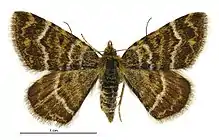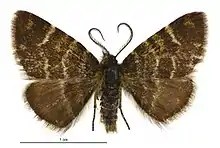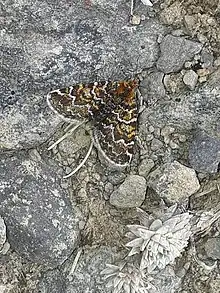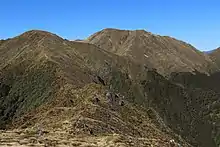Notoreas atmogramma
Notoreas atmogramma is a species of moth in the family Geometridae. This species is endemic to New Zealand. It is a day flying moth that frequents alpine habitat.
| Notoreas atmogramma | |
|---|---|
 | |
| Female | |
 | |
| Male | |
| Scientific classification | |
| Kingdom: | Animalia |
| Phylum: | Arthropoda |
| Class: | Insecta |
| Order: | Lepidoptera |
| Family: | Geometridae |
| Genus: | Notoreas |
| Species: | N. atmogramma |
| Binomial name | |
| Notoreas atmogramma Meyrick, 1911 | |
Taxonomy
This species was described by Edward Meyrick in 1911 using material collected by George Hudson at Mount Holdsworth in the Tararua Range at an altitude of approximately 1200m.[1][2] Hudson discussed and illustrated this species in his 1928 publication The Butterflies and Moths of New Zealand.[3] The lectotype specimen is held at the Natural History Museum, London.[1]
Description

Meyrick described the species as follows:
♀︎. 25-27 mm. Head, palpi, and thorax black, mixed with whitish-ochreous-yellowish hairs and scales. Abdomen black, mixed on sides with whitish-yellow, segmental margins slenderly whitish. Forewings triangular, costa straight, apex obtuse, termen rounded, rather oblique ; dark fuscous, with a few scattered pale - yellowish scales ; lines cloudy, light - yellowish, subbasal, first (and second partially) whitish, first curved, median very indefinite, second angulated in middle, subterminal irregular : cilia white, basal half fuscous. Hindwings with termen rounded ; colour and markings as in forewings, but basal area irrorated with pale yellowish, subbasal and first lines obsolete, second somewhat bent in middle : cilia as in forewings. Under-surface of all wings light ochreous-yellow ; first and second lines indistinctly indicated by whitish suffusion ; forewings with some incomplete cloudy blackish lines ; hindwings with a blackish discal mark.[2]
Distribution

This species is endemic to New Zealand.[4][5] Along with Mount Holdsworth, this species has been found at Mount Taranaki,[6] the Pouakai Range in Taranaki,[7] and Lewis Pass.[8]
Biology and behaviour
This species is on the wing in January and February.[3] It is an alpine moth that is active during the day.[3]
Habitat and host species
The species frequents open grass alpine habitat.[3] Larvae of species within the genus Notoreas feed exclusively on plants within the genera Pimelea and Kelleria.[9]
References
| Wikimedia Commons has media related to Notoreas atmogramma. |
- Dugdale, J. S. (1988). Lepidoptera - annotated catalogue, and keys to family-group taxa (PDF). Fauna of New Zealand. 14. pp. 1–269. ISBN 978-0477025188. Retrieved 12 June 2018.
- Meyrick, Edward (1911). "Notes and Descriptions of New Zealand Lepidoptera". Transactions and Proceedings of the New Zealand Institute. 43: 58–78 – via Biodiversity Heritage Library.
- Hudson, G. V. (1928). The Butterflies and Moths of New Zealand. Wellington: Ferguson & Osborn Ltd. p. 124. OCLC 25449322.
- "Notoreas atmogramma Meyrick, 1911". www.nzor.org.nz. Landcare Research New Zealand Ltd. Retrieved 2018-06-12.
- Gordon, Dennis P., ed. (2010). New Zealand Inventory of Biodiversity, Volume Two, Kingdom Animalia: Chaetognatha, Ecdysozoa, Ichnofossils. Vol. 2. Christchurch, N.Z.: Canterbury University Press. p. 460. ISBN 9781877257933. OCLC 973607714.
- "Notoreas atmogramma Meyrick, 1911 AI.031851". www.tepapa.govt.nz. Retrieved 12 June 2018.
- "Notoreas atmogramma Meyrick, 1911 AI.030964". www.tepapa.govt.nz. Retrieved 12 June 2018.
- "Notoreas atmogramma Meyrick, 1911 AI.030966". www.TePapa.govt.nz. Retrieved 12 June 2018.
- Patrick, BH; Hoare, RJB; Rhode, BE (December 2010). "Taxonomy and conservation of allopatric moth populations: a revisionary study of the Notoreas perornata Walker complex (Lepidoptera: Geometridae: Larentiinae), with special reference to southern New Zealand". New Zealand Journal of Zoology. 37 (4): 257–283. doi:10.1080/03014223.2010.511127.